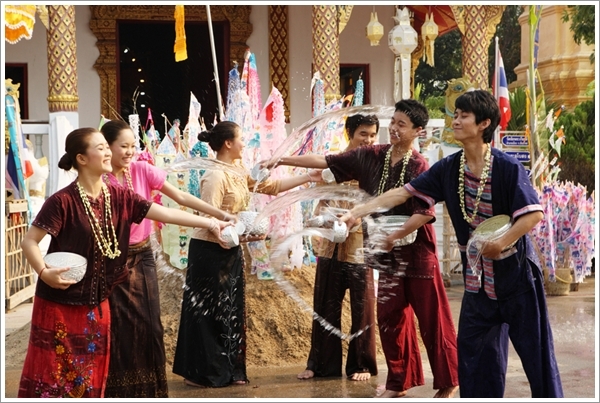Pi Mai Mueang – Songkran Festival of Northern Thailand
Contents

Songkran known as “Thai Water Festival” and “Thai New Year” is well loved domestically and internationally. Every year, the water festival brings tens of thousands of foreign tourists to Bangkok as well as other major towns, including Chiang Mai, Phuket, and Pattaya. Similarly, Thais travel to their hometowns or other provinces to enjoy local Songkarn experiences. Beyond water splashing, Songkarn festival represents various cultural characteristics of Thai’s diverse society.
.
Songkran events at Silom and Khao San Road, with thousands of people carrying water guns, dancing in front of massive stereos, and having their faces painted with white clay may characterize Songkran experience in Thailand. However, there has never been one common way to celebrate Songkran in a country as culturally diverse as Thailand. In the upper northern part of the country, local people celebrate the Thai New Year festival in a different fashion, calling it “Pi Mai Mueang” (ปี๋ใหม่เมือง).
What is Pi Mai Mueang?
Pi Mai Mueang is the New Year festival of the Lanna (ล้านนา) or Mueang (เมือง) people, who inhabit the upper northern part of Thailand, historically known as the Lanna Kingdom. In modern Thai history, eight provinces were part of the ancient Lanna Kingdom – Chiang Mai, Chiang Rai Lampoon, Lampang, Phrae, Nan, and Mae Hong Son. The term “mueang” as in “Kon Mueang” (คนเมือง), the Mueang people, or “Kum Mueang” (คำเมือง), the Mueang language, indicates their Lanna origin. Therefore, Pi Mai Meang means the Lanna New Year (Pi Mai).
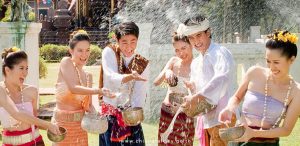
Cr. thelibrary
The earliest documented mention of Pi Mai Mueang was found in the Epigraphic Archives of Wat Pho. It is celebrated about the same time of the year as Songkran when the sun moves from Pisces into Aries in April. This astrological feature was influenced by Hindu astronomy and astrology. The Northern New Year festival, also known as Sungkan (สังขานต์), has the same linguistic origin as Songkran, which means “movement” in Sanskrit. Similarly, Pi Mai Mueang embraces the characteristics of Songkran that are the fusion of Hindu and Buddhist beliefs. However, the influence of the Lanna culture makes Pi Mai Mueang a variation of Songkran that is loved by Thais and foreigners alike.
Activities
Wan Sungkan Long (1st day of Northern Songkran celebration)
The original Pi Mai Mueang celebration lasted five days, beginning on the day the sun enters Aries, but it was reduced to three days to match the official Songkran holidays (13-15 April). The first day of the new year, the 13th April, is called “Wan Sungkan Long” or the transition day from the old year into a new year. It is characterized by the Lanna belief of “Phu Sungkan Ya Sangkan” (ปู่สังขานต์ ย่าสังขานต์) or the Sungkan Grandpa (Phu) and Sungkan Grandma (Ya) who would show up in the early morning of the first day of the New Year to clean up the town before sailing south by the river. Symbolizing the passing of time, Phu Sungkan Ya Sangkan tells people that it is time to embark on a new journey. As a result, on Wan Sungkan Long day, Lanna people will clean their homes and wash their clothes and bodies to remove all dirt and inauspiciousness and welcome the auspicious New Year.
- Dum Hua
“Dum Hua” (ดำหัว), meaning hair washing, is one of the unique aspects of Lanna Songkran performed on the first day of the New Year to wash away inauspiciousness, first for oneself and subsequently for family members. Following the ancient tradition, Lanna people prepare a bowl of holy water by mixing water from holy sources mixed with sompoi (Acacia concinna), a tamarind-like fruit, and scented safflower, and then bless the water with mantra. Along with the holy water, they will build a banana leaf bowl called satuang (สะตวง) to contain their nails and hair after cutting them as part of the Dum Hua ceremony.
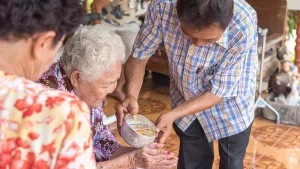
The act of Dum Hua
Cr. thairath
For oneself, the person will face the direction that is auspicious for the New Year Day that year based on the day of the week as given in Lanna calendar, such as facing East if the New Year Day is Friday. Then, he or she will clip their nails and hair and put them into a satuang that will be floating in a river, followed by washing their hair with the holy water. For family members, the head of the family will sprinkle the holy water on the heads of younger family members while blessing them. Such holy water should also be prepared for the elderly in the house to bathe and wash their hair, as well as for cleansing Buddha images on the household altar. In Lanna Songkran, water is used to offer blessings and auspiciousness, as well as to pay respects to revered ones.
- Khun Sangkan
Every year during the Songkran celebration, many Thais wait to see beautiful ladies dressing up as “Nang Songkran” (นางสงกรานต์) or the Goddess of Songkarn. In the tale of the origin of Songkran, the Goddesses of Songkarn are seven daughters of Kabilaphrom, a four-faced deity, who take turns carrying the head of their father on a tray every year to save the world from conflagration if the head touches the ground.
Pi Mai Meung follows a similar tradition of having a deity as a guardian of the year known as “Khun Sungkan” (ขุนสังขานต์). Instead of the goddesses of Songkarn, the Lanna people honor Khun Sungkan or the male deity of Songkran. According to Lanna belief, Khun Sungkan is the Sun God of Songkran, whose clothing, jewelry, weapons, and riding animal changes depending on the day of the week of the New Year’s Day of that year. For instance, if it is Sunday, Khun Sungkan will wear red garment embellished with rubies, wield a lotus in his right hand and a shield in his left, ride on a white horse, and is accompanied by a female angel named Hungsi. Regardless of different color themes and other variations for different days of the week, Khun Sungkan is always portrayed as a bold and elegant god.
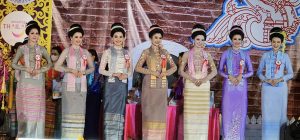
Nang Songkran
Cr. women.kapook
Throughout the three days of New Year celebration, representation of Khun Sungkan is ubiquitous. His image of a Sun God surrounded by groups of angels playing music and throwing flowers in celebration of his journey to the New Year evolved into modern-day Songkran parade with Khun Sungkan, representing Northern Thailand, and the Goddess of Songkran, representing the Central region, as Songkarn events’ highlights, including beauty pageant contests.
Wan Nao (2nd day of Northern Songkran celebration)
The second day of Pi Mai Mueang (14 April) is known as “Wan Nao” (วันเนา), which is considered an inauspicious day among the three days. On Wan Nao, swearing and disputing are forbidden; otherwise, the person may be unhappy for the rest of the year. According to a Lanna tale, there was a noble man who died on the day after Wan Sungkan Long and became a demon with a rotten head. The word “nao” (เนา/เน่า) can also mean “rotten” in Thai. Because of this, Lanna people also believe that cutting bamboo to build a house on Wan Nao will prevent the bamboo from rotting or being eaten by termites.
- Sand pagodas
An inauspicious day like Wan Nao is the perfect time to prepare for merit making. Lanna people usually go grocery shopping to prepare tasty Northen Thai dishes, for family feasts and as offerings to the monks. At local temples, people bring bags of sand to build sand pagodas, believing that they must return sand to the temple as they might have taken grains of sand from the temple in their previous visits. During the activity, the people splash water at each other to cool down after building the sand pagodas in the hot summer sun. To add the final touch, Lanna people would make tung (ตุง), or Northern-Thai style long flags out of colorful papers and bamboo poles to decorate the sand pagodas. In addition to its aesthetic appeal, tung’s long shape is believed to be able to pull sinful souls up from hell.

Sand pagodas
Cr. steemit
- Loy Kroh
On Wan Nao, Lanna people will perform the “Loy Kroh” (ลอยเคราะห์) ceremony to take away unhappiness from the past year by floating a satuang. The special leaf bowl is made of banana tree with a bamboo alter fit inside filled with clay trees, a clay Zodiac animal for the birth year, and a mini meal. A person will bring a satuang to the river, read a mantra, raise it to circle their head three times, float it in the river, and then leave the site without looking back at the satuang until they return home. Despite its unlucky name, Wan Nao is a great day for celebrating a strong community spirit while bringing good luck, happiness, and prosperity through auspicious ceremony and merit making.
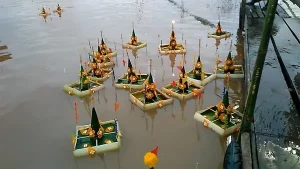
Loy Kroh
Cr. siamcoin.com
Wan Phaya Wan (3rd day of Northern Songkran celebration)
The third and last day (15 April) is called “Wan Phaya Wan” (วันพญาวัน) is the celebration day. Shops are closed so that everyone can participate in auspicious activities as a way to begin off the New Year, such as worshipping their masters, greeting friends, starting an education, to making merit at temples. In the morning, Lanna people visit temples to offer food to the monks, decorate the sand pagodas with more tungs, and wash the Buddha statues with holy water mixed with sompoi and safflower. In return, the monks bless the people in Dum Hua ceremony by rubbing holy water on their heads. In the afternoon, everybody performs the Dum Hua ceremony with the people they respect, mostly the elderly, masters, or superiors. The ceremony provides an opportunity to apologize for any offenses done against the individual and to seek blessings. This shows that Lanna culture places high value on respecting oneself and others as the act of showing respect is one of the first things done at the start of each year.
- Water splashing
Water splashing has always been part of Pi Mai Mueang. Throughout the three days of New Year celebration, everybody has a chance to enjoy splashing water at each other at community events, which mostly take place at temples, such as merit making days on “Wan Nao” and “Wan Phaya Wan” and the sand pagoda building activity. In the past, these were among the rare occasions that young men and women could meet and court each other. Nowadays, water splashing has grown into a larger event than a community gathering. Water festivals as part of Pi Mai Mueang are organized to promote tourism. Famous Northern Songkran festivals, such as Chiang Mai Tha Phae Gate Songkran Festival, attract tens of thousands of tourists domestically and internationally to experience Songkarn at Tha Phae Gate, an iconic historical site in Chiang Mai, with water splashing and Northern Thai cultural performances.
Water splashing
Cr. travel.mthai
Values
Pi Mai Mueang, like Songkran, is a family and community gathering occasion. It represents multiculturalism and diversity in Thailand through the combination of Buddhist, Hindu, and local Lanna cultures seen in beliefs about Northern Songkarn Lanna New Year rituals. Various activities involving water and holy water do not only help with cooling down the summer’s heat, but also bring the community together and build the sense of gratitude, appreciation, and respect for oneself and others. Introspectively, it is also an opportunity to reflect on oneself and how the previous year went. Indeed, the use of water for washing and blessing extends beyond the physical bodies to the inner ones.
Conclusion
Variations of Songkran celebration in Thailand are well worth exploring. Each region of Thailand has its own unique culture that dates back hundreds of years, like Pi Mai Mueang of the old Lanna Kingdom. Such a living culture exemplifies Thai society’s diversity and openness where people of all origins and cultural backgrounds live together in harmony.
The story of the “Pi Mai Mueang” is another charming part of Thai culture. This beloved celebration reflects cultural diversity of Thailand as well as the spirituality of Thai people. It is also a time of family and community bonding through joyful activities and demonstrations of respect towards one another. Join us in exploring more stories of Thailand and the Thai people, as we take you on a journey to discover Thainess.
*****
Sources:
- ป๋าเวณีปี๋ใหม่เมือง
- https://sites.google.com/mfu.ac.th/chiangrai/traditional/tradition/lanna-songkran
- https://www.thailandfoundation.or.th/culture_heritage/songkran-thai-new-year/
- https://www.silpa-mag.com/history/article_99058
- http://cmuir.cmu.ac.th/bitstream/6653943832/20642/5/arc30355pp_ch2.pdf
Author: Natcha Suwanmalee
Editor: Tayud Mongkolrat
29 March 2024



